#CarolineChea
Text
Blogpost #3
Eye Tracking
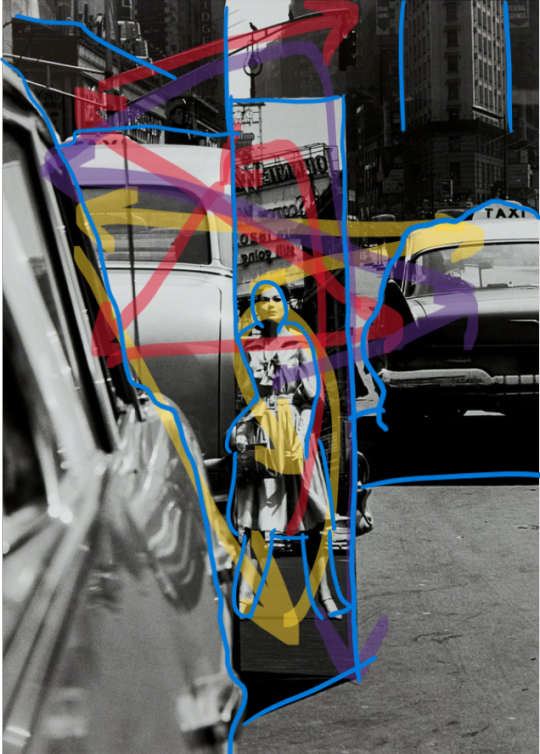
Sandra + Mirror, Times Square, New York (Vogue), 1962-printed 2014. (Photo: William Klein)
The person is inserted to the center of the photo. My eye goes straight to her face and upper body, then to the taxi on the right, and finally to the taxi on the left. I also look at the vertical line on the right, which is stark against the light gray street. The photo looks chaotic with so many elements, but I‘m surprised and impressed by how strongly my eye is drawn to the center line with the eye level of the person and the hoods of the cars.
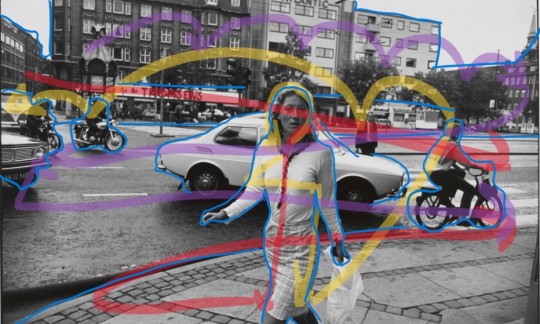
Untitled from Women are Beautiful, 1950-73. (Photo: Garry Winogrand)
The person in the foreground draws my attention so strongly- I actually scan the person completely before looking at any other elements in the photograph. Then my eye bounces to the car and other vehicles that are roughly in a diagonal line. The background of the photo leads left to right, while the person in the foreground is opposing that motion and looking towards the photographer.

Puebla, Mexico 1963, printed late 1960. (Photo: Henri Cartier-Bresson)
The running person and the tilted street line creates a strong motion from left to right. The shadows are quite solid and so my eye next looks at those three dark rectangles. My eye also bounced between the murals and written numbers, names, and the street sign. I took a while to spot the other person leaning on the counter, and to look in the background of the center block, despite it being in the middle of the photo.
Imagined Photographs
I went to Chinatown and walked through the gate down Beach St. For photo 1, I‘d photograph from kneeling on the ground looking up diagonally. In the foreground would be the children on the playground climbing structure. Ideally I‘d wait until one or more kids was poking their head out of the structure, with their face in focus and lit up by the sunlight. Their face takes up at least one third of the bottom of the photo. The midground would be the lanterns strung across the street, arching behind the child’s face so that they are not the focus and identifying the place as Chinese. Then the background would contain the skyscraper, to represent the looming presence of capitalism and urbanism that the child is growing up in.
For photo 2, I‘d take a photo at eye level. I‘d photograph the groups of middle-aged to elderly Chinese men gambling and smoking. The focus would be on a group of 3-4 men gathered around a table, and so the background would be blurry and relatively free of distracting shapes. I would emphasize the attitudes and general atmosphere with the smoke wisps curling around the people. To me, the cigarette smoke is a large part of my Chinatown experience and so the smoky wisps evoke that scent. ‘m a little wary of strangers who are lingering near me and are not clearly waiting for transportation or something, so I would ideally photograph with one or two smokers on the edge, almost out of frame to represent a peripheral awareness.
3 notes
·
View notes
Text
Blogpost #2
Flusser’s assumption that the two major turning points of human history are the invention of writing and the invention of imagery strikes me as an extraordinary simplification. Their implication that writing was a negative for society also struck me as strange, especially since their theory is conveyed through writing. I did like the statement that “[images] are supposed to be maps but they turn into screens.” The activeness turned into passivity is a nice way to put it. Additionally, Flusser’s description of cameras as a black box apparatus is interesting, though I feel the language complicates the meaning. Most electronic devices and many other modern day technologies obscure their inner workings from their users.
I enjoyed Sontag’s section about the physicality of printed photos. A printed photo can fade and be torn and marked over time, and so itself becomes an image. I also enjoyed the transition sentence of “As photographs give people an imaginary possession of a past that is unreal, they also help people to take possession of space in which they are insecure,” in reference to the family photos and travel photos respectively. I‘ve certainly taken tourist photos simply because people had agreed that this site was photographable, rather than really taking in the site and taking photos that end up more unconventionally attractive. Sontag also writes about voyeurism and how photography inherently requires distance. I‘d argue that the intimacy of the scene and implied trust is quite voyeuristic. Finally, I love the poignant written imagery of “Precisely by slicing out this moment and freezing it, all photographs testify to time’s relentless melt.”
0 notes
Text
blogpost #14
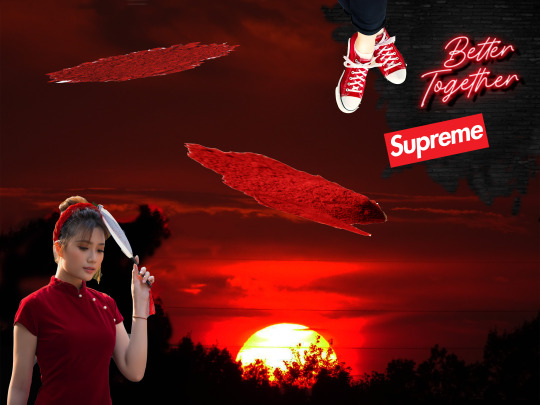
Red-dominated collage.
I drew on the bold redness of capitalism and its brand logos - Vans and Supreme, along with the eye-catching neon lights. I also included the red pigments of cadmium red and alizarin crimson. The woman wearing a qipao represents the celebration of red in Chinese culture. And the red sunset brings the sometimes ominous cast of a red glow.
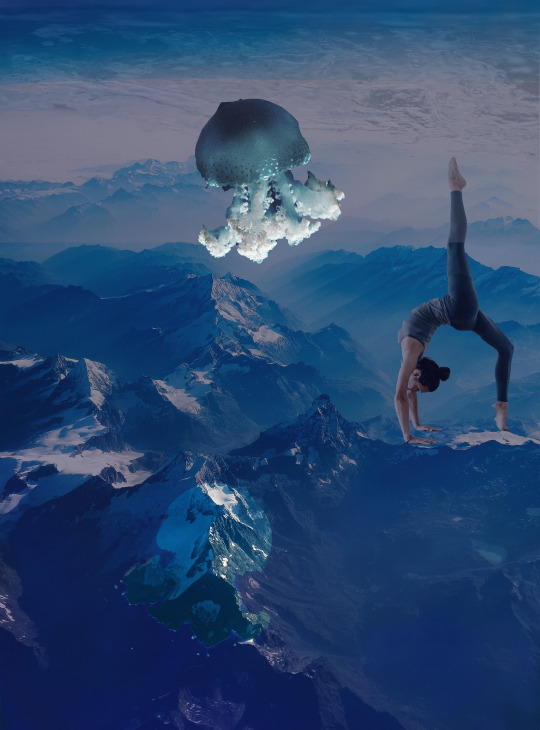
Blue-dominated collage.
This blue collage mixes the blue of distant mountains and skies, and the dimmer blue of the ocean. There's more layers stacked onto each other for this collage: the blue mountains as the background, the waves as a texture at the top, and the darker blue of the deep ocean. I've also included a yoga pose, which I associate with the calmness of blue.
0 notes
Text
blogpost #13
In reading Derek Jarmon’s “On Seeing Red”, I do relate to seeing red as a pigment. I‘ve painted with acrylics and oils, and cadmium red and alizarin crimson are such strong pigments that I only need a little to make something redder. I also associate red with capitalism, with many bright red logos and packaging (Target, Supreme, and Dorito’s comes to mind) because research has shown that red is attention-grabbing and attractive. Red is also a dominant color in Chinese culture, especially for New Year’s. Decorations, lanterns, and calligraphed banners are usually red, along with the traditional dress of a qipao. I don’t relate as much to the red in flowers or in symbolizing love. I shy away from the thorniness of red roses, and I don’t particularly find it romantic.
In reading Rebecca Solnit’s “The Blue of Distance”, I do like this poetic portrayal as blue as distance. When I “feel blue”, I feel sad and melancholic. The “blueness” is distant from energy and more isolated from other people. Solnit mentions nature in relation to blueness, but apart from blue skies and once in a while the blue seas, I find green and brown a more apt color for nature. Blue is a naturally rare color in nature, and the blueness of skies is from the reflecting of light and its wavelengths. And so I do like the line on pg 38 that states “Some light does not make it all the way through the atmosphere, but scatters,” in relation to memories.
0 notes
Text
blogpost #12
“The Waste Land” draws on numerous allusions to different cultures, along with evoking images upon images, shifting from one vision to the next. The first stanza describes spring as harsh and cruel, in contrast to winter. I‘m pleasantly surprised by this subversion of how the seasons are usually portrayed, and reminded of how I actually like the fresh crisp feel of winter air in compared to the often muggy feel of spring. For the second part of the poem, I have the vision of luxurious materials in a room, worth a lot of money but in an empty way. Then follows this more repetitive, broken up stanza in which “speak” and “think” are repeated desperately several times. ‘m unsettled by these stanzas, which break from the familiar format of the first part. There’s also the urgency of “HURRY UP PLEASE ITS TIME” which screams out to me amidst the conversational lines. This poem has many more images that went over my head due to the allusions that I don’t understand, but even so this poem draws on universally tragic imagery.
I used both regular and magnetic lasso to outline the eagle and the crouching person. I used the color dropper, brush, and heal tool to extend the sky to the rest of the top of the canvas. Then I repaired the hair of the person with a clone stamp. Text was added with the text tool. Finally, I cropped the image, and flattened and darkened the image with the curve.

0 notes
Text
blogpost #11-a
At LIFE exhibit at the MFA, I thoroughly enjoyed the multimedia representation of photography from framed prints to photos in newspapers to images on TV. Alexander Bell’s marginalia and rearrangement of the NYT front pages was striking, and really does force me to critically think about how the arrangement and framing portrays news stories. I also appreciate how the exhibit brings in the process of taking the photos by showing the contact sheets and bringing in the magnifying glass.
The section that covered Paul Schutzer’s photos of Berlin in 1961 were interesting to me, particularly seeing the contact sheet and what other potential images there were. The caption file lends more meaning to the photo, giving context for why the photo with one of the citizens looking up was selected. There’s that morbid, tragic sense of capturing people actually being at a site of death via jumping. I can see how the caption files help to retain focus on the reality of what was happening there, and therefore to help with the truth-seeking of photojournalism overall.
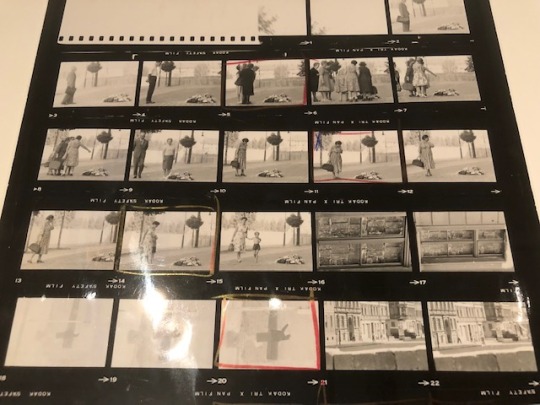
Paul Schutzer, Contact sheet of negatives, 1961 (LIFE exhibit at MFA, viewed 11/9/22)

Will Lang, Pages from caption file for photographs taken by Paul Schutzer, 1961 (LIFE exhibit at MFA, viewed 11/9/22)

Paul Schutzer, 1961 (LIFE exhibit at MFA, viewed 11/9/22)

Paul Schutzer, Commemorating death of East Berlin woman who tried to escape from sealed city, 1961 (LIFE exhibit at MFA, viewed 11/9/22)
0 notes
Text
blogpost #10-a
I found the gentle humor of the dialogue and narration rather beautiful. Varda’s comments are simple and quaint in an almost elegant way. The comments are her interpretation of the images, which does feel a little too explanatory. While watching the film, I found myself focusing more on the overlying dynamic between Varda and JR, more than people’s stories. Despite stating in the beginning of the film that these encounters were spontaneous, hearing their stories somehow felt forced, likely because of how short of a time we spent with them.
As for the large-format photos themselves. Pasting such large images on surfaces is ambitious- I wish the film went more into the process and any hiccups they may have encountered rather than talking about it retrospectively. I also got the impression that locals were a little speechless and uncertain about what to say, which I suppose is a reaction itself. Many reactions were that the image was “pretty” or “ugly”.
I wonder if any of the film’s tone comes from French culture.
0 notes
Text
Blogpost #2
Flusser’s assumption that the two major turning points of human history are the invention of writing and the invention of imagery strikes me as an extraordinary simplification. Their implication that writing was a negative for society also struck me as strange, especially since their theory is conveyed through writing. I did like the statement that “[images] are supposed to be maps but they turn into screens.” The activeness turned into passivity is a nice way to put it. Additionally, Flusser’s description of cameras as a black box apparatus is interesting, though I feel the language complicates the meaning. Most electronic devices and many other modern day technologies obscure their inner workings from their users.
I enjoyed Sontag’s section about the physicality of printed photos. A printed photo can fade and be torn and marked over time, and so itself becomes an image. I also enjoyed the transition sentence of “As photographs give people an imaginary possession of a past that is unreal, they also help people to take possession of space in which they are insecure,” in reference to the family photos and travel photos respectively. I‘ve certainly taken tourist photos simply because people had agreed that this site was photographable, rather than really taking in the site and taking photos that end up more unconventionally attractive. Sontag also writes about voyeurism and how photography inherently requires distance. I‘d argue that the intimacy of the scene and implied trust is quite voyeuristic. Finally, I love the poignant written imagery of “Precisely by slicing out this moment and freezing it, all photographs testify to time’s relentless melt.”
(I accidentally posted this onto my student blog, so I'm reposting this here now!)
0 notes
Text
Blogpost #1
For further back than I can remember, my family has been a stickler for taking family photos while traveling. There’s a photo of my family at a theme park, when I was young enough to need a stroller. My parents have told me that I was happily munching on a churro, and now I cannot tell whether I remember that far back or that the photo was visually stimulating enough that I can imagine the scene. That archive of a moment that I may or may not actually remember is fascinating to me.
After acquiring a phone with a camera in middle school and being exposed to Instagram photos of picturesque dishes and aesthetic outfits, I realized that different types of photos existed besides the posed family photos. I‘m most drawn to photographing the natural and built landscape. The gentle ombres of the setting sun and the layered textures of the clouds catch my eye while ‘m walking around. Taking photos makes me appreciate the vibrancy of colors I can see and the full expanse of the open sky. The limited frame of photos forces me to reevaluate my perspective and how I want to preserve the scene I'm capturing.
I have taken one digital photography class online. In addition, I keep an Instagram art account where I occasionally document my art or post photos. My summer UROP also requested that I take process photos of my bookbinding process. I‘d like to learn to further study the city by photographing the built environment and streetlife.
An image that marked me most recently is one of the sun shining through clouds, framed by a wire fence. I was walking in the suburbs with a friend and was struck by the gloriously lit sky. We were crossing over a railroad and after a few snaps with the fence interfering, I decided to use the fence as a framing device.
(I accidentally posted this onto my student blog, so I'm reposting this here now!)
0 notes
Text
blogpost #10
In the beginning of the short story, the narrator says that “[My father] was, I think, very handsome. I gather this from photographs and from my own memories of him, dressed in his Sunday best[....]”. The story is in medias res, with the narrator jumping from scene to scene in a nonlinear timeline. This feels much like jumping from photograph to photograph, flipping through a non-chronological photo album. This is further emphasized by how the scenes are in the moment and so visually descriptive. The people involved are detailed with outfits and appearance and color. The emotions in the scene are supplemented by the narrator’s memories, similar to how photographs can trigger memories with strong emotions such as fear.
One vivid example is when the narrator writes about the “brownout” on the streets. He describes it as having “the force of an optical illusion, or a nightmare”, and that “it seemed to me[...]that all of the people I could see[...]were moving toward me, against me, and that everyone was white.” I feel this is emphasizing his point of view and this visual metaphor of all being black and everyone else being white and moving against him. The scene draws on this image, one that is described so clearly that you can feel the visceral unease. I can imagine taking this photo of walking against a flow of people, with white (maybe overexposed or glowing) faces.
0 notes
Text
blogpost #9-1
I found John Berger's "Ways of Seeing" refreshing in its discussion of images in terms of reproductions of paintings. I enjoy going to the gift shops of museums, which feature a variety of reproductions onto products, from framed replicas to postcards to jewelry to shirts. There's the sense that you can have this wonderful fancy painting in your home, that it can belong to you. My family has a framed replica of a Monet hanging over our couch. I recently saw a woman wearing a shirt that replicated a Van Gogh painting. These paintings have been recontextualized by being placed in an entirely new space. In the case of the shirt, the painting is even on the move, walking down the street and being wrinkled by movement.
In this discussion of space, I'd also be curious about murals and graffiti, which can be so defined by the spaces that they're in. For example, a couple of MIT's dorms have murals that are shaped by and continue to shape floor cultures. In the case of Random Hall, the narrow, short hallways give a specific meaning and feeling to the murals that adorn those walls. One corner is painted with "Wall left intentionally blank" and an arrow pointing around the corner at a blank wall.
As paintings are two-dimensional, I would then question how this discussion applies to sculptures that are three-dimensional and being reproduced in virtual reality.
0 notes
Text
blogpost #9
The provoking boldness and starkly vivid text of Barbara Kruger’s images caught my eye. Kruger uses large black and white images overlaid with phrases in Futura Bold or Helvetica Extra Bold typeface in black, white, or red text bars. This modern type makes the text slick and contributes to the declarative phrases. The phrases directly address the audience with the first- and second-person pronouns of “I” and “you”, which prompts the viewer to take in the photo as their own. The phrasing feels almost accusatory to me, authoritatively asking questions to the viewer. Her work pokes violently at society and our identities, for example criticizing consumerism and embracing feminism.
Kruger has worked with photography, graphic design, sculpture architecture, and video and audio installations. With a background in graphic design, Kruger’s work has been installed in the public, such as on billboards, bus wraps, and landscape architecture. Ironically, she has also designed products such as T-shirts and mugs. Her method includes conceptualizing on her computer with found images and text, and then transferring the results onto printed images, often large-scale. I can see the influence of graphic design in the clear font and color choice, along with the placement of the text and its weight in the image. Interestingly, her work is the direct inspiration for Supreme’s logo. That logo became iconic in my high school too, so much so that one of my class’s t-shirt design included an imitation of the white font on red text bar logo.

Barbara Kruger, Call number: N6537.K78 A4 1999 (Rotch library)

Barbara Kruger, Untitled (Don't be a jerk), billboard, Melbourne, Australia, 1996.

Barbara Kruger, Untitled (We are astonishingly lifelike/ Help! I'm locked inside this picture), 1985.

Barbara Kruger, Untitled (I will not become what I mean to you), 1983
0 notes
Text
blogpost #7
Watching The Salt of the Earth has emphasized to me how photographic trips are journeys. Each of Salgado’s trips are poignant deliberations on people. Salgado converses with people both physically and photographically, and I enjoyed how Wendel shows that Salgado interacts with and deeply cares about humanity. The compassion shines through the photos of devastating conflicts too.
I liked that Wendel allowed viewers time to take in the photos for themselves, with commentary that provided more context. The disturbing photos of dehydrating bodies, catastrophic fires, and other tragedies require time to process. Wendel also alternates the photos with moving film to further inform the viewers. But the photos remain the highlight of the documentary, because after all, photography is Salgado’s medium of choice and fame.
0 notes
Text
blogpost #8
The Magnum Photos Cooperative allows photographers to retain the rights to their photos, and so this allows them to act independently of magazines, newspapers, and other employers. Magnum has many photojournalists, which makes sense due to the sensitive emotional and political subjects. Photojournalism can show raw truth to such an extent that it makes people uncomfortable.
Steve McCurry is known for shooting the cover of National Geographic issue in June 1985, which is considered one of the “most recognized” photographs of National Geographic. The photo is Afghan Girl, featuring a Pashtun orphan with piercing eyes, from a Pakistani refugee camp. McCurry was born in Philadelphia, Pennsylvania, and studied theater arts at Pennsylvania State University. He went on to work at a newspaper, where he traveled and was snuck into the Pakistan border and took photos to show the brutality of the Russian invasion. Since then McCurry has traveled across the seven continents and photographed conflicts and vanishing cultures. He shoots in both film and digital, but prefers transparent film.
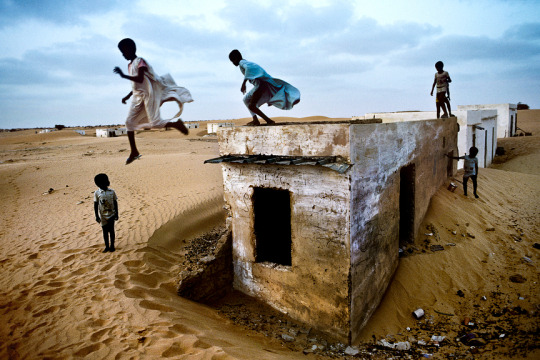
Steve McCurry, Mauritania.

Steve McCurry, Pokhara, Nepal.

Steve McCurry, Havana, Cuba.
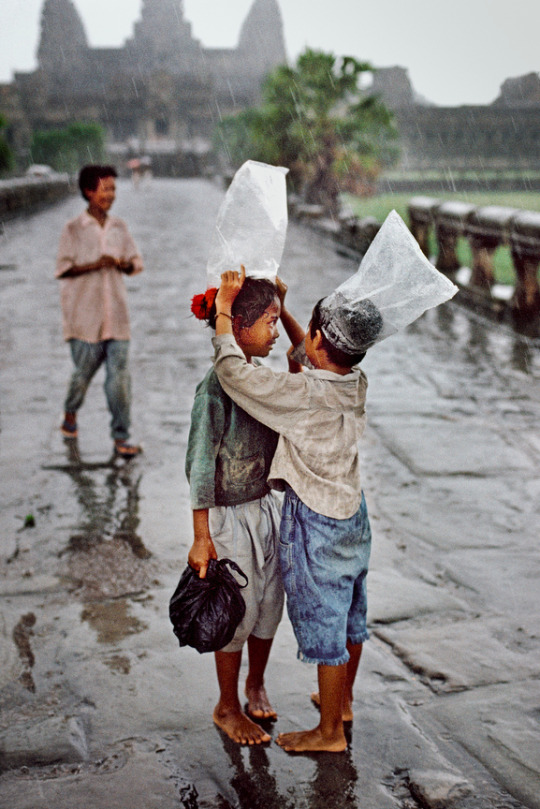
Steve McCurry, Angkor Wat.
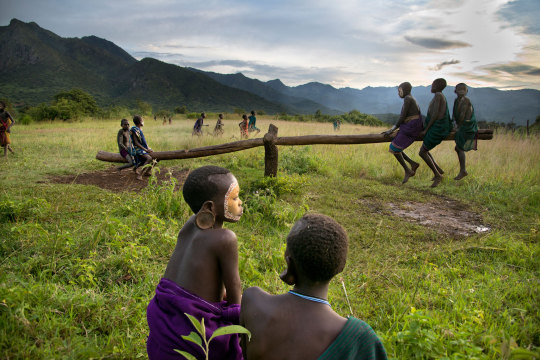
Steve McCurry, Omo Valley, Ethiopia.
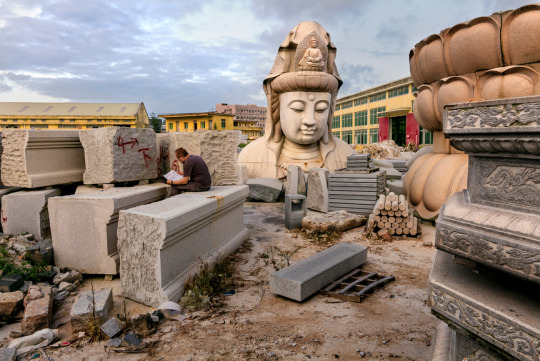
Steve McCurry, Quanzhou, China.

Steve McCurry, Rome, Italy.
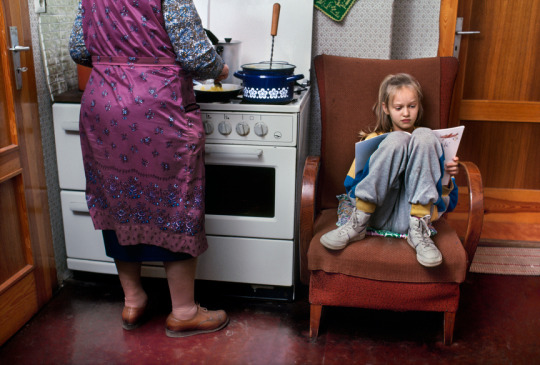
Steve McCurry, Flechtingen, Germany.
0 notes
Text
blogpost #6
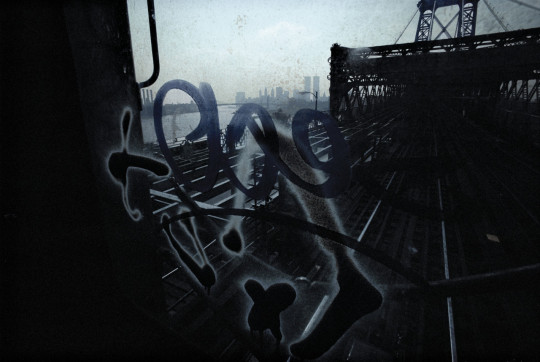
Bruce Davidson USA. New York City. 1980. Subway.
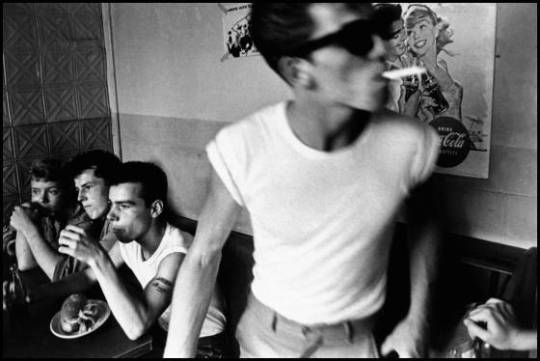
Bruce Davidson USA. New York City. 1959. Brooklyn Gang.
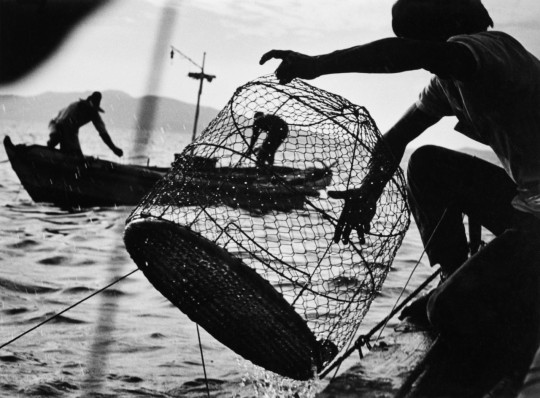
W. Eugene Smith Fishing. Minamata Bay, Japan. 1972
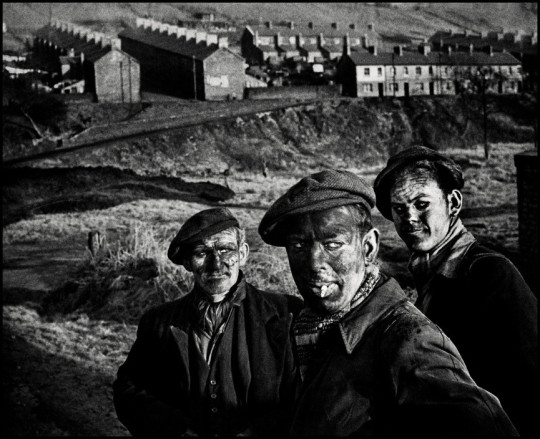
W. Eugene Smith | Let Truth be the Prejudice Three generations of miners. A Welsh coal-mining town. Wales. 1950.
I appreciate Davidson's dedication in going back and reflecting on the photos, to not just shoot and leave. Because photos inherently breach privacy, taking as much value as possible and considering the impact of your work feels important. Davidson's emphasis that you should know what you do NOT want in a photo is helpful to me, because I often focus on the ideal shot I want to take but can't quite achieve.
Smith's take on adding light sources to take photos reminds me of photo editing. The philosophy of #nofilter argues against using any filters, usually on Instagram. Photo-editing can bring a photo closer to reality, or just closer to an artistic vision. I think that adding light sources can add or take away from the authenticity of the photo, depending on the photographer's intentions and use. Smith talks about sometimes needing to come back to retain the atmosphere, which I found interesting.
Smith also talks about how the technology of faster lenses does not make more and better photographers. While I agree that slowing down and understanding the purpose of the tech is important, I also think that the faster and more inexpensive lenses are more accessible and allow people to experiment and have quicker feedback.
1 note
·
View note
Text
Blogpost #5

Martha Cooper, Graffiti Died by Json & Seen, 1982
I enjoy how Martha Cooper waits for the trains to come by, and the patience and alertness that that would require. In this photo, I like how the train is above the city buildings, which is a reversal of my expectation that the train would be firmly on the ground. The large blocky shadow of the bridge and the skyline underneath makes me feel like I'm peering under the train, a little.

Martha Cooper, Style Wars by NOC 167, Manhattan, 1981
The juxtaposition of the wildly scribbled graffiti and the businessman in proper suit and tie and reading a newspaper is delightful. I also enjoy Martha Cooper's timing so that the doorway frames the businessman so clearly. The graffiti of a train on a train is also amusingly meta and on full display at second glance.
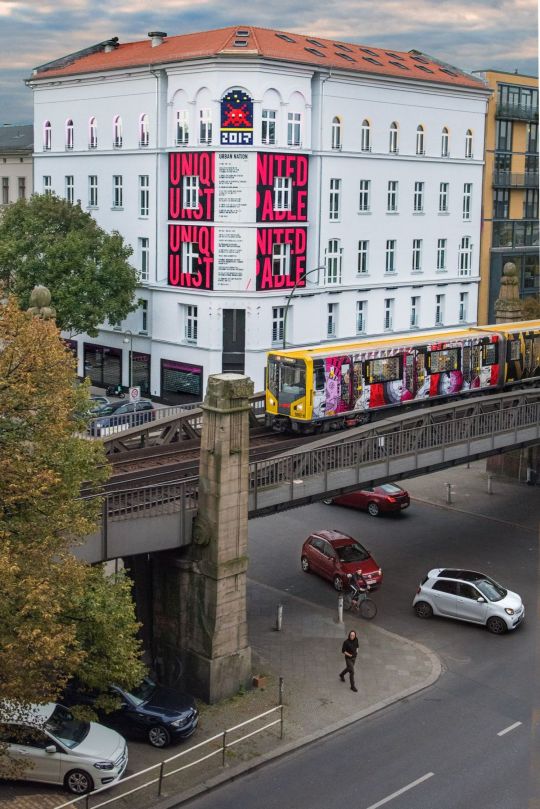
Martha Cooper, How & Nosm, Fairey, and Faust Train, Berlin, 2017
I like the layers and angles that are neatly presented in this photo. There's a lot of dimensionality from this point of view, with the corner of the building and support structure of the bridge visible.
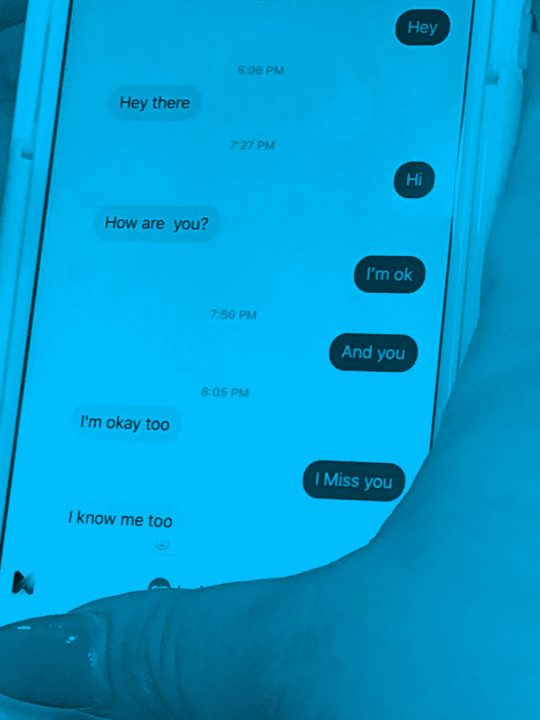
Jeff Mermelstein & MACK, From “#nyc,” 2020
Jeff Mermelstein's #nyc is a photo collection of texts. I adore how this is an archive of a conversation, but in a way that presents more than just a screenshot. The photo includes the actual cell phone and hand in the frame, making it feel more in the moment and first-person rather than third-person.
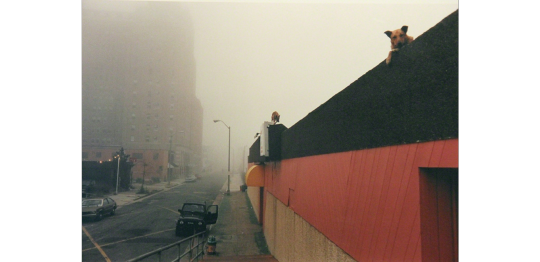
Jeff Mermelstein, Atlantic City
This just feels like such a silly photo with on eof the dogs peeking over the wall. I'm impressed by how much my gaze is directed towards the dog in the corner, due to the strong line of the wall and the otherwise foggy background.
0 notes